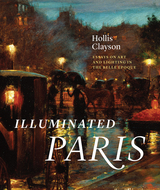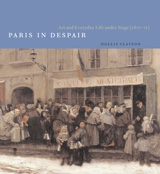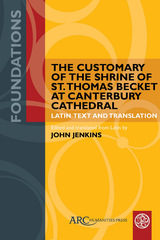2 books by Clayson, S. Hollis

Illuminated Paris
Essays on Art and Lighting in the Belle Époque
Hollis Clayson
University of Chicago Press, 2019
The City of Light. For many, these four words instantly conjure late nineteenth-century Paris and the garish colors of Toulouse-Lautrec’s iconic posters. More recently, the Eiffel Tower’s nightly show of sparkling electric lights has come to exemplify our fantasies of Parisian nightlife. Though we reflect longingly on such scenes, in Illuminated Paris, Hollis Clayson shows that there’s more to these clichés than meets the eye. In this richly illustrated book, she traces the dramatic evolution of lighting in Paris and how artists responded to the shifting visual and cultural scenes that resulted from these technologies. While older gas lighting produced a haze of orange, new electric lighting was hardly an improvement: the glare of experimental arc lights—themselves dangerous—left figures looking pale and ghoulish. As Clayson shows, artists’ representations of these new colors and shapes reveal turn-of-the-century concerns about modernization as electric lighting came to represent the harsh glare of rapidly accelerating social change. At the same time, in part thanks to American artists visiting the city, these works of art also produced our enduring romantic view of Parisian glamour and its Belle Époque.
[more]

Paris in Despair
Art and Everyday Life under Siege (1870-1871)
Hollis Clayson
University of Chicago Press, 2002
The siege of Paris by Prussians in the fall and winter of 1870 and 1871 turned the city upside down, radically altering its appearance, social structure, and mood. As Hollis Clayson demonstrates in Paris in Despair, the siege took an especially heavy toll on the city's artists, forcing them out of the spaces and routines of their insular prewar lives and thrusting them onto the ramparts (as many became soldiers).
But the crisis did not halt artistic production, as some have suggested. In fact, Clayson argues that the siege actually encouraged innovation, fostering changed attitudes and new approaches to representation among a wide variety of artists as they made art out of their individual experiences of adversity and change—art that has not previously been considered within the context of the siege. Clayson focuses especially on Rosa Bonheur, Edgar Degas, Jean-Alexandre-Joseph Falguière, Edouard Manet, and Henri Regnault, but she also covers a host of other artists, including Ernest Barrias, Gustave Courbet, Edouard Detaille, Pierre Puvis de Chavannes, Albert Robida, and James Tissot. Paris in Despair includes more than two hundred color and black-and-white images of works by these artists and others, many never before published.
Using the visual arts as an interpretive lens, Clayson illuminates the wide range of issues at play during the siege and thereafter, including questions of political and cultural identity, artistic masculinity and femininity, public versus private space, everyday life and modernity, and gender and class roles in military and civilian society. For anyone concerned with these issues, or with nineteenth-century French art in general, Paris in Despair will be a landmark work.
But the crisis did not halt artistic production, as some have suggested. In fact, Clayson argues that the siege actually encouraged innovation, fostering changed attitudes and new approaches to representation among a wide variety of artists as they made art out of their individual experiences of adversity and change—art that has not previously been considered within the context of the siege. Clayson focuses especially on Rosa Bonheur, Edgar Degas, Jean-Alexandre-Joseph Falguière, Edouard Manet, and Henri Regnault, but she also covers a host of other artists, including Ernest Barrias, Gustave Courbet, Edouard Detaille, Pierre Puvis de Chavannes, Albert Robida, and James Tissot. Paris in Despair includes more than two hundred color and black-and-white images of works by these artists and others, many never before published.
Using the visual arts as an interpretive lens, Clayson illuminates the wide range of issues at play during the siege and thereafter, including questions of political and cultural identity, artistic masculinity and femininity, public versus private space, everyday life and modernity, and gender and class roles in military and civilian society. For anyone concerned with these issues, or with nineteenth-century French art in general, Paris in Despair will be a landmark work.
[more]
READERS
Browse our collection.
PUBLISHERS
See BiblioVault's publisher services.
STUDENT SERVICES
Files for college accessibility offices.
UChicago Accessibility Resources
home | accessibility | search | about | contact us
BiblioVault ® 2001 - 2024
The University of Chicago Press









